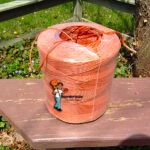Tomato Twine Vs Bailing Twine
I’m going to make this a very short topic and get right to the point. If you grow tomatoes each year and have issues with breaking or stretching string, this topic may help to resolve your issues. I have seriously been growing heirloom and open pollinated tomatoes for the last 25 years and it never occurred to me that I could use bailing twine to effectively support my tomatoes. I’ve tried everything, including expensive, so called tomato twine, but I still had breaking, especially towards the end of the season, or earlier if the growing season was rainy. Then I discovered another type of twine and decided to write this topic and name it tomato twine vs bailing twine. Read on!
A few years ago I purchased some bails of straw for mulching my garden and it suddenly occurred to me that I had never seen a broken straw bail twine. I decided to inquire. What I found out was very surprising! In fact, I was so surprised that I couldn’t believe that I didn’t think about it before.
One Of My Biggest Tomato Discoveries
 Since 2005 I have been purchasing so called special tomato twine that was very expensive. At that time they cost me $20 per spool. Ten years later the same spool cost me $31.00. After my bailer twine brainstorm I decided to pay a visit to my local farm store. There I found polypropylene premium bailer twine for sale in two pack quantities and two different strengths. The strengths and lengths were 20,000 feet at 110 pound tensile strength, and 10,000 feet at 220 pound tensile strength. I decided to purchase a 2 pack each of the two different strengths( The big news was that the 2 pack cost just $20.00. Boy what a deal if only it would work. To make a long story short, I am still using that very same string to this day. Here is how I use the different strengths. I use the 110 lb tensile strength for tying and bracing plants. The 220 lb tensile strength I use as my main weight bearing support. Those I run at the very top of my T-posts from post to post. Then I use the 110 to tie the top of the vines to that very top 220 string. I prune very little so I have plenty of vines to tie up to that first string. The 110 is easier for tying things because it’s not as thick.
Since 2005 I have been purchasing so called special tomato twine that was very expensive. At that time they cost me $20 per spool. Ten years later the same spool cost me $31.00. After my bailer twine brainstorm I decided to pay a visit to my local farm store. There I found polypropylene premium bailer twine for sale in two pack quantities and two different strengths. The strengths and lengths were 20,000 feet at 110 pound tensile strength, and 10,000 feet at 220 pound tensile strength. I decided to purchase a 2 pack each of the two different strengths( The big news was that the 2 pack cost just $20.00. Boy what a deal if only it would work. To make a long story short, I am still using that very same string to this day. Here is how I use the different strengths. I use the 110 lb tensile strength for tying and bracing plants. The 220 lb tensile strength I use as my main weight bearing support. Those I run at the very top of my T-posts from post to post. Then I use the 110 to tie the top of the vines to that very top 220 string. I prune very little so I have plenty of vines to tie up to that first string. The 110 is easier for tying things because it’s not as thick.
Colors, Colors, Colors
If you are fortunate, you will find bailer twine in several high visibility colors too. So far, I have seen them in white, orange, blue, green and yellow. I like that because I can use certain colors for different functions and create an effective system. I have only seen tomato twine listed in white.
So in conclusion, bailer twine works more effectively than any tomato twine that I have ever used. At the end of my seasons, my twine is still strong and unbroken. I usually grow about 1,000 plants each season, and in the last 4 years or so I have not had any breakages, no, not once! With the tomato twine I had many! Hope this article has helped you to make your gardening experience even better!





